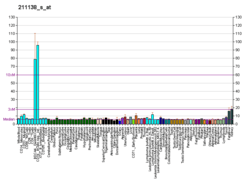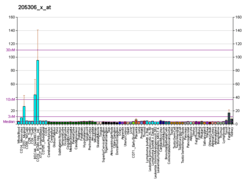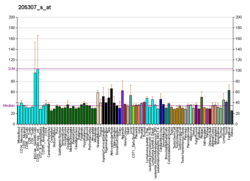KMO (gene)
Kynurenine 3-monooxygenase is an enzyme that in humans is encoded by the KMO gene.[5][6]
Kynurenine 3-monooxygenase (KMO; EC 1.14.13.9) is an NADPH-dependent flavin monooxygenase that catalyzes the hydroxylation of the L-tryptophan metabolite L-kynurenine to form L-3-hydroxykynurenine.[supplied by OMIM][6] This is the first step in the degradation of Kyneurinine to Quinolinic acid. This pathway is involved in the activation of cytokine mediated changes in behavior due to inflammatory stimuli such as infections.[7]
References
- 1 2 3 GRCh38: Ensembl release 89: ENSG00000117009 - Ensembl, May 2017
- 1 2 3 GRCm38: Ensembl release 89: ENSMUSG00000039783 - Ensembl, May 2017
- ↑ "Human PubMed Reference:".
- ↑ "Mouse PubMed Reference:".
- ↑ Alberati-Giani D, Cesura AM, Broger C, Warren WD, Rover S, Malherbe P (Sep 1997). "Cloning and functional expression of human kynurenine 3-monooxygenase". FEBS Lett. 410 (2–3): 407–12. doi:10.1016/S0014-5793(97)00627-3. PMID 9237672.
- 1 2 "Entrez Gene: KMO kynurenine 3-monooxygenase (kynurenine 3-hydroxylase)".
- ↑ Dantzer R, O'Connor JC, Lawson MA, Kelley KW (2011), "Inflammation-associated Depression: From Serotonin to Kyneurenine", Psychoneuroendocrinology, 36 (3): 426–36, doi:10.1016/j.psyneuen.2010.09.012, PMC 3053088, PMID 21041030
Further reading
- Stone TW, Darlington LG (2002). "Endogenous kynurenines as targets for drug discovery and development". Nature Reviews. Drug Discovery. 1 (8): 609–20. doi:10.1038/nrd870. PMID 12402501.
- Aoyama N, Takahashi N, Saito S, et al. (2006). "Association study between kynurenine 3-monooxygenase gene and schizophrenia in the Japanese population". Genes, Brain and Behavior. 5 (4): 364–8. doi:10.1111/j.1601-183X.2006.00231.x. PMID 16716206.
- Gregory SG, Barlow KF, McLay KE, et al. (2006). "The DNA sequence and biological annotation of human chromosome 1". Nature. 441 (7091): 315–21. doi:10.1038/nature04727. PMID 16710414.
- Ligam P, Manuelpillai U, Wallace EM, Walker D (2005). "Localisation of indoleamine 2,3-dioxygenase and kynurenine hydroxylase in the human placenta and decidua: implications for role of the kynurenine pathway in pregnancy". Placenta. 26 (6): 498–504. doi:10.1016/j.placenta.2004.08.009. PMID 15950064.
- Strausberg RL, Feingold EA, Grouse LH, et al. (2003). "Generation and initial analysis of more than 15,000 full-length human and mouse cDNA sequences". Proc. Natl. Acad. Sci. U.S.A. 99 (26): 16899–903. doi:10.1073/pnas.242603899. PMC 139241. PMID 12477932.
- Halford S, Freedman MS, Bellingham J, et al. (2001). "Characterization of a novel human opsin gene with wide tissue expression and identification of embedded and flanking genes on chromosome 1q43". Genomics. 72 (2): 203–8. doi:10.1006/geno.2001.6469. PMID 11401433.
- Breton J, Avanzi N, Magagnin S, et al. (2000). "Functional characterization and mechanism of action of recombinant human kynurenine 3-hydroxylase". Eur. J. Biochem. 267 (4): 1092–9. doi:10.1046/j.1432-1327.2000.01104.x. PMID 10672018.
This article is issued from
Wikipedia.
The text is licensed under Creative Commons - Attribution - Sharealike.
Additional terms may apply for the media files.






